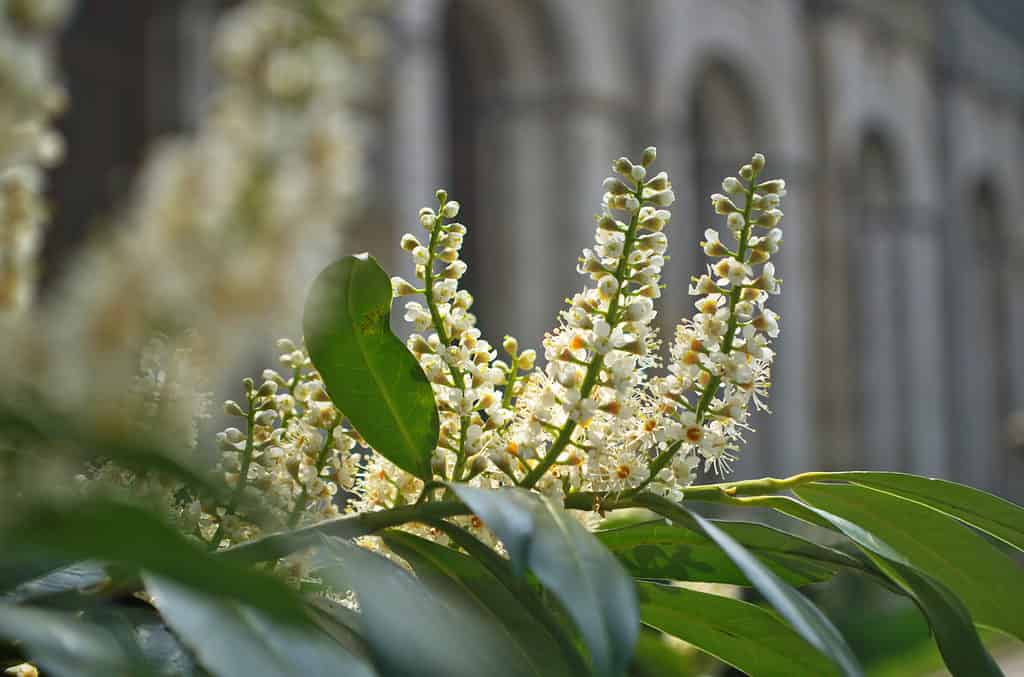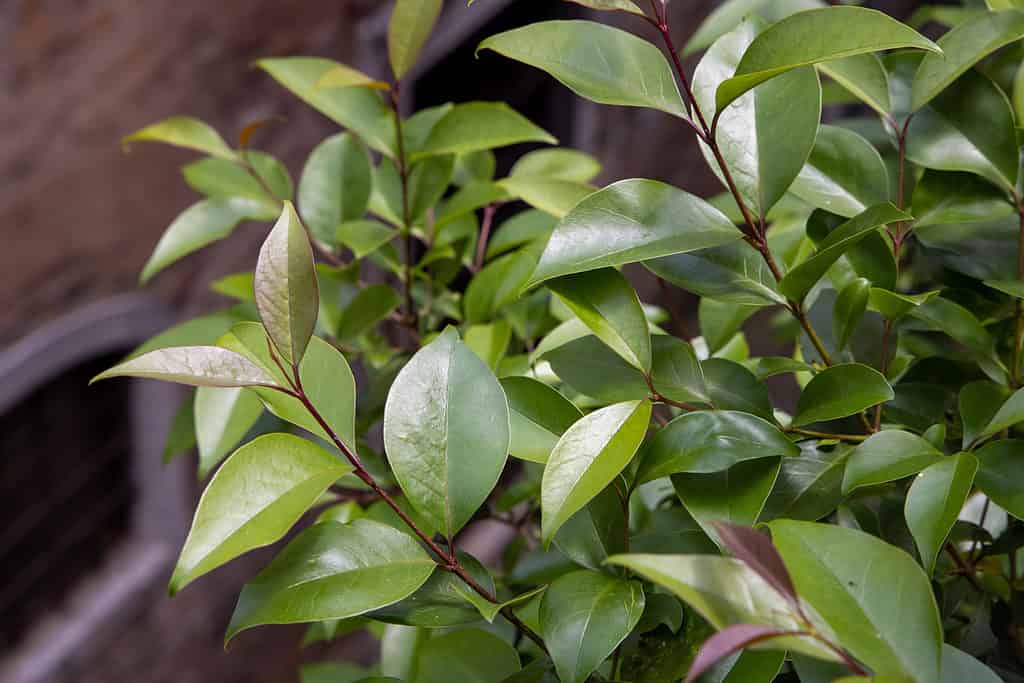If you’re into gardening, landscaping, or exterior design, you might have heard about English laurel and cherry laurel before. They are some of the most common laurels used for hedging. However, how do you differentiate English laurels from cherry laurels? So, how can we spot an English laurel plant? What do its flowers, leaves, and fruits look like, and are their fruits edible? Here’s everything you need to know about this laurel species!
Is There a Difference Between English and Cherry Laurel?

The only difference between the English laurel and the cherry laurel is their names. They are the same plant!
©LifeisticAC/Shutterstock.com
Interestingly, English laurel and cherry laurel are the same plants, so there’s no difference between them. They are common names used interchangeably to refer to the same hedging plant.
English Laurel Size and Growth Rate
The English or cherry laurel is an evergreen shrub or tree. In ideal conditions, it has a rapid growth rate, adding about 1 to 2 ft (12 to 24 inches) to its height annually, and can grow up to 20 ft (240 inches) tall in the wild.
English Laurel Appearance

The English laurel produces leathery, glossy leaves about 6 inches long and smells like cherry when bruised.
©ajisai13/Shutterstock.com
The English laurel produces leathery, glossy leaves about 6 inches long and smells like cherry when bruised. It also produces fragrant white flowers that have a strong plum scent. These flowers grow in upright racemes and measure less than an inch.
The English/cherry laurel fruits may look like berries, but they are actually called drupes, which are fleshy fruits with seeds in the center covered in a hard, woody layer. The English/cherry laurel fruits have several color variations, including lavender, purple or black.
English Laurel Classification

The scientific name of English or cherry laurel is Prunus laurocerasus.
©Boumen Japet/Shutterstock.com
You could wonder why a hedging plant would smell like plum or cherry. The English laurel has a plum or cherry-like scent because they belong to the Prunus genus from the rose (Rosaceae) family. The scientific name of English or cherry laurel is Prunus laurocerasus.
English laurels have several cultivars. The most famous among them is the ‘Otto Luyken’ cultivar, which has gained the Royal Horticultural Society’s Award of Garden Merit.
There are 40 English laurel cultivars, including:
- Prunus laurocerasus ‘Rotundifolia’
- Prunus laurocerasus ‘Novita’
- Prunus laurocerasus ‘Caucasica’
- Prunus laurocerasus ‘Etna’
- Prunus laurocerasus ‘Marbled White’ (also known as Prunus laurocerasus ‘Castlewellan’ or ‘Variegata’)
- Prunus laurocerasus ‘Zabeliana’
English Laurel Cultivation
The English or cherry laurel thrives in alkaline soil. It can grow in both shade and full sun. Moreover, English laurel is a hardy plant that grows in various conditions as long as there is good soil drainage.
There are two ways to plant English laurel. You can either propagate and plant from cuttings or plant them from seed. If you’re planning to grow a cherry laurel from seed, it will require cold stratification for 2 to 3 months before sowing. You may put the seeds in a bag with a compost mix and then let it stay in the fridge for 2 to 3 months.
English Laurel Hardiness Zones
The Hardiness Zone Map is a standard map of 13 geographic zones that contains significant information indicating whether or not a plant may survive in a certain location. It was last updated by USDA in 2012 based on the average annual minimum temperature from the last 30 years. English or cherry laurel is hardy in USDA zones 6 to 8.
English Laurel Uses
The English laurel plant is mainly used for gardening and landscaping. Its broad leaves serve as hedges for homes, gardens, and parks.
Its foliage is usually paired with roses in the floral industry for weddings. This perfect combination of classic and elegant styles is said to be a sustainable approach in floral design businesses.
According to Turkish traditional medicine, cherry laurel has analgesic, antispasmodic, narcotic, and sedative effects. It was used to treat cough and asthma, while its water has antifungal properties. Online sources show the medical benefits of cherry laurel water, which leads us to the question—Are cherry laurel leaves beneficial or toxic?
English Laurel Toxicity

English laurel contains cyanide, a highly toxic chemical compound that can harm our brain, heart,
blood vessels
, and lungs.
©Peter Turner Photography/Shutterstock.com
English laurel belongs to the genus of trees and shrubs that produce cherries. They contain cyanide, a highly toxic chemical compound that can harm our brain, heart, blood vessels, and lungs. Cyanide poisoning can occur through skin contamination, ingestion, or inhalation. However, cyanide is a key ingredient in plastics processing, pesticide fumigation, and gold and silver extraction.
Therefore, ingesting cherry laurel fruits should be avoided. You must also use gloves when touching or trimming leaves or stems. The leaves and the seeds are the most toxic if ingested. If any part of the English or cherry laurel is ingested, you must immediately seek medical attention.
Cyanide poisoning symptoms may include:
- Difficulty in breathing, gasping, and panting
- Pupil dilation
- Spasms, convulsions
- Respiratory failure
- Coma
Wildlife Value: Are English Laurels/Cherry Laurels Dangerous to Animals?
English or cherry laurels are used as garden hedges. However, you must be cautious in adding these plants to your yard. English laurel is dangerous to humans and some pets. Ingesting even a small amount of laurel can be dangerous to your dogs, cats, horses, cattle, pigs, cows, and other animals.
Surprisingly, birds love cherry laurel fruits, which are not dangerous to them. Robins and cedar waxwings eat the fruits of English/cherry laurels, especially during autumn and winter.
The English laurel is also a host plant to caterpillars, particularly the eastern tiger swallowtail. The diet of swallowtail larvae consists of magnolia, olive, laurel, and rose families.
UP NEXT
- Skip Laurel vs Cherry Laurel: Is There a Difference?
- Laurel Oak vs. Live Oak
- Discover the 5 Fastest-Growing Trees in Texas
The photo featured at the top of this post is © ajisai13/Shutterstock.com
Sources
- ScienceDirect, Available here: https://doi.org/10.1016/j.indcrop.2013.12.047
- NC State University, Available here: https://plants.ces.ncsu.edu/plants/prunus-laurocerasus/
- Clemson Cooperative Extension, Available here: https://hgic.clemson.edu/factsheet/laurel/
Thank you for reading! Have some feedback for us? Contact the AZ Animals editorial team.






